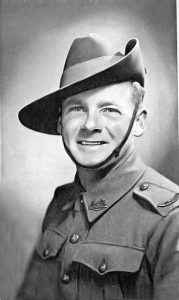There were a number of 2/4th men (8) who managed to escape Singapore Island, only to be taken POWs of Japan at Sumatra, then part of Netherlands East Indies.
Richard Annear, Burgess, Ted Hopson, Arthur Magill, Quinn, Semple, Harold Smith and Squance
Ted Hopson died 26 April 1944, was buried 200 yards south of 28 kilo peg on Blangkejeren-Tekencong Road.
(Ted Hopson’s grave was never located by War Graves, hence his body remains in Sumatra)
Following the sinking of POW Transport Ship SS Harujkiku in 1944, Burgess, Semple and Harold Smith remained Singapore with injuries or illness.
Richard Annear, Arthur Magill, Quinn and Squance returned to Sumatra and the Railway with Java POWs Banks, Booth and McAskil (Booth and McAskil died of illness on the Railway in 1945)
FIVE (5) 2/4TH MEN WERE RECOVERED FROM RAILWAY AT END OF WAR.
This escape route went across the Durian Straits between Singapore and Sumatra and then traced the Indragiri River, which was one of several east-west rivers past the towns of Tembilihan, Rengat as far as Ayer Molek. From here it was necessary to move on foot to Padang on the southwest coast of Sumatra.
From Padang of course those on the run hoped to be rescued by a ship and evacuated to safety!
Arthur Magill and Cliff ‘Squasher’ Squance reached Sumatra
During a Japanese ambush on 11 February 1942 at South-West Bukit Timah, Arthur Magill WX16886 who two days earlier at Bulim Village had been wounded in his neck and armpit, had his rifle shot out of his right hand and received two gunshot wounds to his 3rd and 4th fingers as well as his leg. Cliff ‘Squasher’ Squance WX16885 who was wounded in his left shoulder, managed to escape the scene of the ambush and assisted Arthur Magill over an embankment.
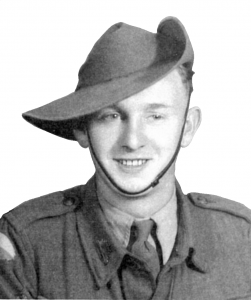
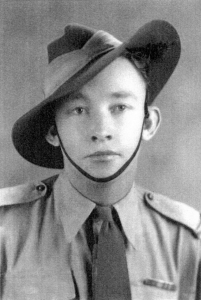
Right: Squasher Squance
Left: Arthur Magill
The two men headed for the coast where they met up with three other ‘fugitives’. They were Ron McLellan from Queensland, an English soldier and an Indian Sepoy.
The five fugitives managed to ‘borrow’ a dinghy equipped with an outboard motor from a seaside resort near Pasir Panjang. As the five men climbed into the dinghy they were joined by a further two men – the Rush brothers from 2/18th.
The group of 7 men motored away from the shoreline and against an outgoing tide until they eventually ran out of petrol. They were forced to put into an island in Keppel Harbour, close to Singapore City.
A vote was taken and it was decided to continue with their escape bid to Sumatra where they hoped they may be rescued.
They traded the dinghy with some locals for what they hoped would be in exchange for transport to Sumatra!
In darkness the men were taken in the general direction of Sumatra and dropped off at an island. During what must have been a worrying time for the escapees, they remained here for four days until the local island natives decided harbouring soldiers from Singapore could bring about terrible Japanese retribution.
Finally the locals plucked up sufficient courage to transport the seven men to another island where they were once again left to their own resources.
It was here that a Chinese junk arrived and picked them up. There were about 120 men already on board and another 120 escapees waiting on the island. The junk, greatly overloaded reached Sumatra but required a tow from a Dutch launch for part of the way up the swift flowing Indragiri River. This river was not easily navigated and eventually the men were forced to disembark at Ayer Molek.
The passengers now began their trek across Sumatra on foot, towards Padang.
Because ‘Squasher’ and Arthur Magill required medical attention for their wounds, the two men stopped at a hospital at Sawahunto. They continued on their quest but like most others striving for what they hoped would greater options towards freedom, they ran out of time before they were captured by the Japanese.
Richard Winston Annear better known as ‘Win’ WX13468 escaped from Singapore some time after Monday 16 February 1942 when Singapore was firmly under Japanese control.
Win who was in the company of two other 2/4th men, could see no rational reason why they should surrender and suggested they make a break for Sumatra.
Remember these men had been fighting for their lives for 8 or more days. They had been fired upon by Japanese mortars for hours and hours leaving them sleepless and the fighting had been had at times desperate, there had been great loss of life and in some areas, loss of leadership. The two men accompanying Annear made the decision they were utterly exhausted and hungry. They decided to return to Singapore and give themselves up.
Annear decided to go alone.
“I had $40 on me so I paid a native one dollar to row me to the next island where I picked up some other chaps.
From here we set off towards Sumatra and after many trials and foodless days we arrived at Sumatra, at a town called Rengat. There we met up (unfortunately) with an organised evacuation party which only slowed our travel. We eventually made the other coast of Sumatra, tired and hungry at a place called Padang, but by the time of our arrival we were two days too late and the last boat had already gone and the next one was sunk coming in. We were lucky that we missed these boats as very few of them got through the Japanese net.
Just before the Japs took Padang six of us decided to head south. All the Padang chaps were taken prisoner on 17 March. We, after much walking made it to a tea plantation and from there we took to the jungle where we stayed for two months eating weeds or rice, brown beans and trapping our own deer, the longest we went without meat was three days.
Eventually the natives gave us away 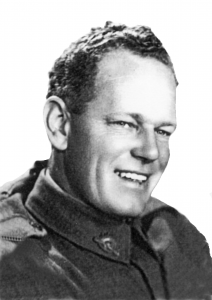
– we found ourselves back at Padang POW Camp on 9 May 1942. All the chaps there were starving and we were as fat as butter, then we starved along with them.”
Right: Annear
Hopson, Edward (Ted)
Listed as missing from Pasir Panjang on Sunday evening 15.2.1942. Hopson escaped with ‘Atjeh Party’ to Sumatra and was soon captured by the Japanese. He remained a POW in Sumatra with Magill WX16886 and Quinn WX9285.
Frank Thaxter WX7248 (fitter with Aust. Army Ordnance Corps) wrote just a few words of Hopson’s escape.
“5 or 6 of us decided to make a break with Tom’s blessing (Bunning).”
From the above, we estimate Frank was in the party attempting escape but was unsuccessful.
Ted Hopson of ‘B’ Coy 7 Platoon reached Sumatra where he was not so long after, captured by the Japanese. He very tragically died at Tenal Gajoe hospital with appendicitis – unable to be operated on due to the fact Ted also had dysentery. Ted was a very popular bloke and the men in Sumatra were affected by his death on 26 April 1944.
Others who escaped Singapore to Sumatra included Burgess, Harold Smith, Semple and Quinn.
Burgess, Smith and Semple survived the sinking of SS Van Waerwjick, were rescued, taken to Singapore where they remained behind due to Illness when the party returned to Sumatra.
WX7532, SEMPLE, Robin Roy (Bluey) Semple enlisted AIF Aug 1940 later joined 2/4th MGB’s ‘D’ Coy 15 Platoon under Commanding Officer Lt Meiklejohn.
Please read further about ‘D’ Coy, 15 Platoon.
He was wounded in action on 9/2/1942 receicing gunshot wounds to both legs and left upper arm. Semple escaped to Sumatra where he was captured and interned at Padang, Gloe Gloer Camp (Medan).
During the battle for Singapore the battalion was engaged in heavy fighting for 20 hours before being overrun by the enemy.
(Private Dudley Athelstan Annear, WX13457 of 2/4 MGB was killed in action at Singapore on 14 February 1942. He was attempting to escape with several others of the Platoon who had been trapped behind Japanese lines. He was 31. Bill Bell was also killed during this time.)
Following the sinking SS Harujkiku, Semple remained behind in Singapore he was fortunate to avoid working on the Sumatran Railway.
WX17448 SMITH, Harold.
Harold Smith enlisted AIF 27 Oct 1941 and was sent with reinforcements for 2/4th MGB, entrained from Northam to Fremantle boarding troop carrier ‘Aquitania’ at Gage Roads, Fremantle where he joined ‘E’ Company, Special Reserve Battalion. He was at south west Bukit Timah during the ambush when so many from this Battalion lost their lives.
Smith was listed as missing following the ambush at South-West Bukit Timah.
He escaped to Sumatra where he was imprisoned at Padang, Gloe Gloer Camp. He was moved to Singapore with the Hirukiku Maru Party – it was sunk by British submarines. All but 169 POWs survived in the water about 4 hours before a Japanese tanker came by and picked them up. They were taken to Singapore to River Valley Transport Camp for about a month before the POWs were sailed back to Sumatra. Harold was another POW to remain behind in Singapore – he suffered burst appendix.
(Three) 2/4th remained in Singapore, all suffering illness and didn’t continue their journey back to Sumatra. Harold Smith, Semple and Burgess.
Leaving (Four) men to return to work in Sumatra on the Railway: Quinn, Annear, Squance and Magill who were joined by (Three) Java POWs from 2/4th – McAskil, Booth and Banks. (Total 7 men worked on the Railway – 5 survived)
A further (3) 2/4th men imprisoned on Java joined the Sumatran group at Singapore and sailed to Sumatra to work on the Railway 1944/1945. McAskil, Booth and Banks. Banks was the only one to survive and return home.
Right: Ted Hopson
Others to reach Sumatra
Ted Hopson WX9241 from ‘B’ Company also managed to escape from Singapore on Sunday night 15 February 1941.
Others included Cecil Quinn WX9285 from ‘D’ Company who was wounded at Lim Chu Kang Road. Alfred Burgess WX15756 and Harold Smith WX17448 from ‘E’ Company Special Reserve Battalion also escaped to Sumatra.
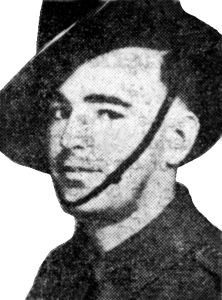
Left: Cecil Quinn
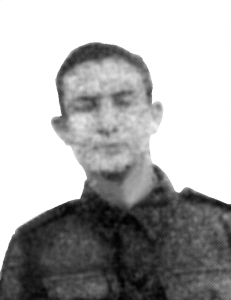
Right: Burgess
Below: Harold Smith
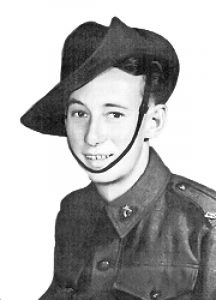
Read about other escapes from Singapore to Sumatra
Please read about the evacuation of POWs from Sumatra to Singapore at end of war.

